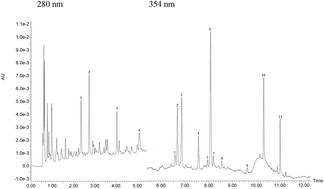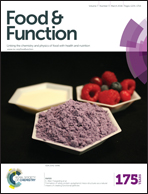Grape skin phenolics as inhibitors of mammalian α-glucosidase and α-amylase – effect of food matrix and processing on efficacy
Abstract
Type-2 diabetes is continuously increasing worldwide. Hence, there is a need to develop functional foods that efficiently alleviate damage due to hyperglycaemia complications while meeting the criteria for a sustainable food processing technology. Inhibition of mammalian α-amylase and α-glucosidase was studied for white grape skin samples recovered from wineries and found to be higher than that of the drug acarbose. In white grape skins, quercetin and kaempferol derivatives, analysed by UPLC-DAD-MS, and the oligomeric series of catechin/epicatechin units and their gallic acid ester derivatives up to nonamers, analysed by MALDI-TOF-MS were identified. White grape skin was then used for enrichment of a tomato puree (3%) and a flat bread (10%). White grape skin phenolics were found in the extract obtained from the enriched foods, except for the higher mass proanthocyanidin oligomers, mainly due to their binding to the matrix and to a lesser extent to heat degradation. Proanthocyanidin solubility was lower in bread, most probably due to formation of binary proanthocyanin/protein complexes, than in tomato puree where possible formation of ternary proanthocyanidin/protein/pectin complexes can enhance solubility. Enzyme inhibition by the enriched foods was significantly higher than for unfortified foods. Hence, this in vitro approach provided a platform to study potential dietary agents to alleviate hyperglycaemia damage and suggested that grape skin phenolics could be effective even if the higher mass proanthocyanidins are bound to the food matrix.



 Please wait while we load your content...
Please wait while we load your content...